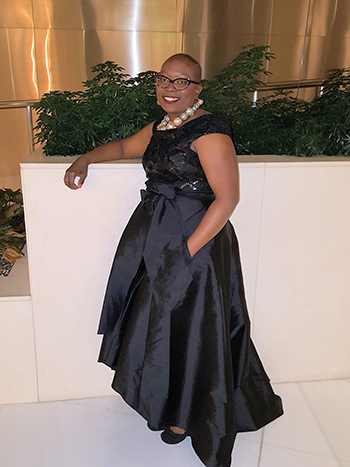HER2+ Breast Cancer Survivor
Trust yourself and insist on the care you deserve

Shontrice Patillo knows that if she hadn’t been persistent, her future could have looked drastically different. After successful treatment for Stage II invasive ductal carcinoma, she took on the role of advocate for patients and health equity. She promotes early detection, transparency within families and the need for more breast cancer research.
Have you ever heard that breast cancer usually isn’t associated with pain? Or that you “just have dense breasts”? I heard both quite a few times as I was undergoing tests to find out what was causing pain in my breast, but I didn’t believe either because I knew something wasn’t right. And, after nearly four months of persistence, I learned my pain was caused by Stage II, ER positive/PR positive/HER2 positive invasive ductal carcinoma. It just goes to show that every diagnosis affects every person differently, and it is critical to listen to your body and trust yourself.
The radiologist who called me with the diagnosis referred me to a breast surgeon, who recommended I have a lumpectomy immediately. My husband thought it sounded like a good plan, but I wasn’t comfortable. Was there cancer elsewhere in my body? Would a lumpectomy be enough? I wanted more information, but the surgeon was pretty set on his plan.
My sister connected me with a local cancer center for a second opinion, and my experience was completely different. The nurse navigator sent information to me before my first appointment. I then met with the oncologist, who was very upbeat. He explained the type of cancer I had, and he had a “we can fix this” attitude. His plan of action started with chemotherapy, not surgery, so we could see how the cancer reacted and if it had metastasized. I had questions, and he had answers. We were included in the decision- making, and I felt much more comfortable with his approach.
Treatment would begin the following week, so my adult daughter and a friend met in Orlando to celebrate my son’s 6th birthday at Disney World. We got home on a Sunday in late April, and I had a port put in the next day so I could begin what would be six rounds of chemotherapy right away.
After the first round, I met with a surgeon who wanted to do an MRI of both breasts, not just the one with the cancer. Results showed the tumor had almost disappeared, but cancer was identified in my other breast. After the second round of chemotherapy, my surgeon performed a core biopsy to remove the entire new tumor. It wasn’t showing us any markers, however, and she thought that was likely because the chemotherapy had been so effective.
After finishing all the rounds of chemotherapy, I had a double mastectomy and began the reconstruction process in September. I had DIEP flap reconstruction that used fat, blood vessels and tissue from my stomach to build my breasts. The reconstruction process lasted three years. A little more than a year later, I had nipples put on as the last step of the process. I was advised to wait to do that until I was sure that all my reconstruction needs were taken care of because this would signal the insurance company that I was “done.”
I took hormone therapy for a year but had extremely high levels of estrogen and progesterone, so I followed my oncologist’s recommendation to have a hysterectomy.
After my treatment ended, I realized I’d learned so much that I felt an urgent need to be a breast cancer advocate. I advocate at the state and national levels, in person and virtually, to promote equity among minorities, the need for research and more. Additionally, I am a member of a patient research advocacy team that empowers survivors and advances quality, patient-focused cancer research and care. The program provides the opportunity to work closely with researchers to design research that may lead to improved treatments and therapies.
I also encourage people to share their stories. Several women in my family have had breast cancer and colon cancer, including my mom, who passed away from complications of colon cancer just days after I had the DIEP flap procedure. But cancer was not something we talked about. It was always a whisper, or “so and so is having something taken care of with her female organs.” This is not personal business. We need to share our health conditions with our family members because many cancers are genetically linked. It can start with this simple question: Who in our family has had cancer and what kind?
Listen to your gut. If something doesn’t feel right or even if a medical professional doesn’t say or do the right thing, get a second, third or fourth opinion. Lastly, know your body. You know what your normal is.


